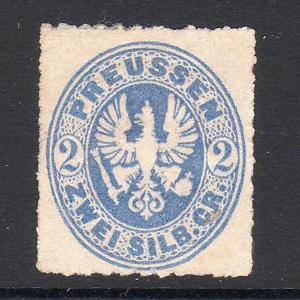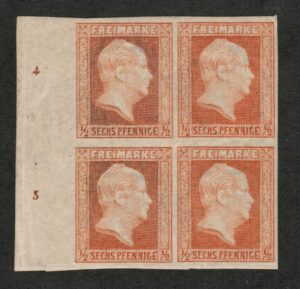
Prussia issued 27 different stamps. None of them are rare, as the active commercial economy of Prussia necessitated much postal communications. Prussian post offices encouraged the use of postage stamps whereas some of the smaller German states did not. This means that a plentiful supply of Prussian stamps have reached collector hands. Many Prussian stamps were remaindered out after the stamps were demonetized after Prussia joined the German confederation. Most of the stamps of Prussia were printed by engraving, which make for fine impressions and mean that there are very few counterfeits of these stamps for collectors to worry about. There are even a couple stamps that were printed in reverse on goat beater skin paper- a translucent paper that was used experimentally as an anti-counterfeiting measure (counterfeiters would have trouble getting the paper and the design of the stamp would be damaged when the stamp was soaked off the envelope making cleaning and re use impossible as well).

Specialty Catalogs: The Michel catalog is used by advanced specialists, but most serious American collectors of Prussian stamps use the Scott Classic catalog.
Specialty Albums: The Scott specialty series is very good, but because so many Prussian specialists collect more than just one stamp of each issue, many collectors make their own pages and albums.

Expense: Because of the level of commerce and wealth in Prussia and the relatively small number of stamps issued, Prussian stamps are plentiful. Prussia is one of the least expensive major countries to complete.
Overall Grade: B+
